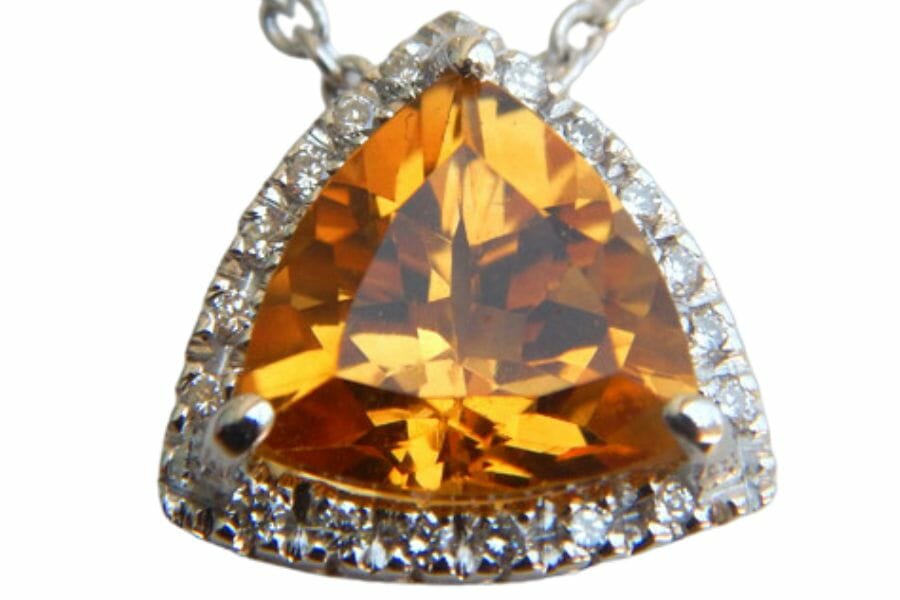Citrine gemstones have been prized for their beauty and durability for centuries. It stands out for its radiant yellow-gold hue, which is said to bring positive energy and abundance into the wearer’s life. However, not all citrine jewelry or specimens are created equal, and it can be challenging to tell the difference between authentic and fake citrine.
Identifying authentic specimens is pretty important since the price of citrine is often much higher than a fake. You don’t want to overpay for something created in a lab!
There has been an influx of fake citrines hitting the market as more and more are produced overseas and shipped in. They can be tricky to spot for the untrained eye but there are some easy ways to tell the difference between a real and fake citrine.
Understanding What Citrine Is
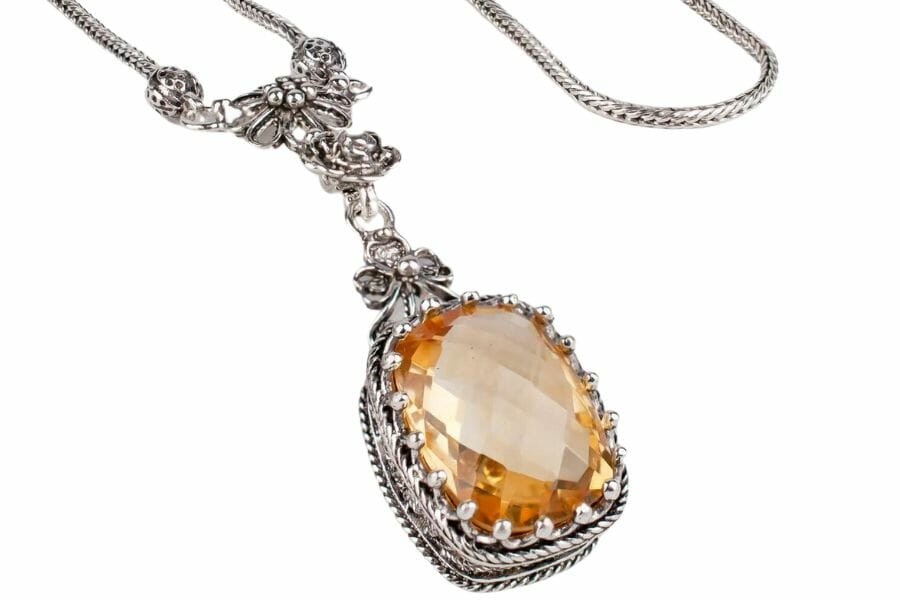
Photo provided by Artisan Crafted Silver
Citrine is a fascinating mineral that is essentially a transparent variety of quartz, which is one of the most abundant minerals on Earth’s crust. Its name comes from the French word “citron,” meaning lemon, due to its vibrant yellow color.
We have spent a lot of time in the popular places to mine for gems and have found our share of citrines. Citrine can have different shades that range from pale yellow to deep orange, depending on the level of iron and other impurities present during its formation.
One of the most interesting things about citrine is that it is typically found in geodes or nodules, often alongside amethyst, another popular quartz variety. These geodes and nodules can be found in various locations around the world, including Brazil, Madagascar, and the United States.
Citrine makeup
The chemical composition of citrine is SiO2, the same as other quartz varieties, but its color and optical properties are distinct. Citrine can be found in nature or synthetically made in a laboratory, where the natural color of quartz is enhanced by irradiation or heat treatment.
Synthetic citrine is often sold as “lemon quartz” or “sun quartz,” but it lacks the energetic and metaphysical properties associated with natural citrine.
It is worth noting that not all natural citrine is created equal. Some citrine is actually heat-treated amethyst, which can result in a yellowish color.
While this citrine is still considered natural, it may not have the same energetic properties as citrine that formed naturally with iron impurities.
The Importance of Real Citrine
Citrine is a versatile mineral that can be used in many ways, from jewelry-making to home decor. Wearing citrine jewelry, such as a pendant or bracelet, can promote positive energy and help dispel negative thoughts and emotions.
Authentic citrine is highly valued not only for its aesthetic appeal but also for its perceived healing and cleansing powers.
Citrine is believed to purify the aura, boost self-confidence, and attract prosperity and abundance. However, these benefits are only attainable if the citrine used is natural and untreated.
Synthetic or fake citrine may have a similar look but lacks the inherent energy and essence that sets apart natural citrine. It is important to be aware of this when purchasing citrine jewelry or other items that claim to contain citrine.
Even if you don’t believe in any energy properties, fake citrine just doesn’t have the same beauty and sparkle that the real deal does.
What Real Citrine Looks Like
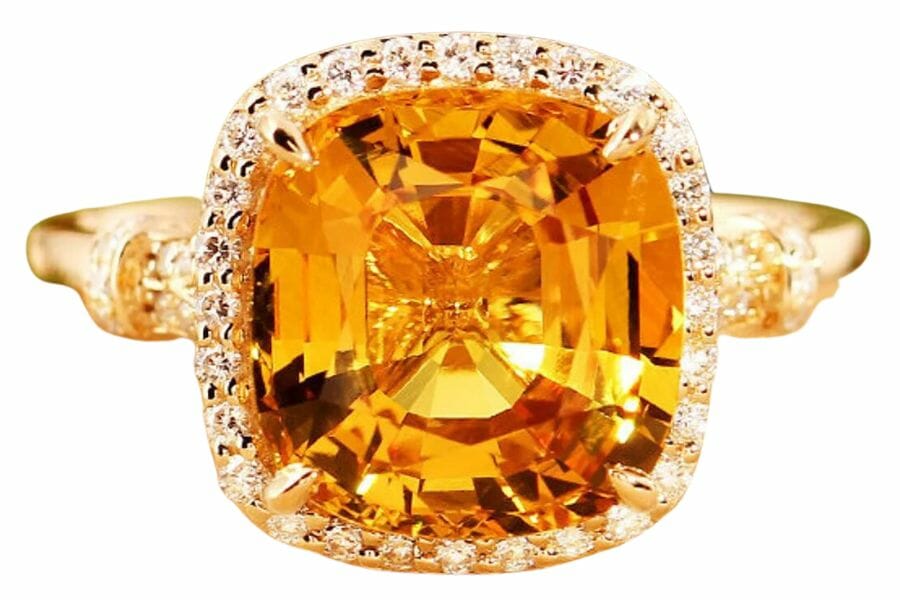
Photo provided by Yvbard Jewelry
Citrine is a beautiful and unique gemstone that is highly valued for its golden-yellow color and natural imperfections. Here are some additional characteristics of real citrine that you should know:
Natural Citrine Color and Appearance
As mentioned, natural citrine has a distinctive golden-yellow color that sets it apart from other quartz varieties. This color is caused by iron impurities in the crystal structure, and can sometimes have hints of orange or brown.
There are several different citrine colors that you might come across. Check out the link above to see the full variety of colors with examples.
When held up to the light, citrine has a transparent or translucent appearance that allows you to see its internal inclusions and formations. These inclusions are natural imperfections that give each citrine stone a unique character and story.
Inclusions and Clarity
Inclusions are a natural part of citrine and can include tiny crystals, bubbles, or other minerals. These inclusions can add to the beauty and uniqueness of the stone, but excessive inclusions can compromise its integrity and reduce its value.
Clarity refers to how transparent or clear the gemstone is, and can vary depending on the origin and formation of citrine. Natural citrine is generally less clear than other quartz varieties, such as rock crystal or amethyst, but this does not necessarily detract from its beauty.
Formation and Structure
Citrine can form in a variety of ways, including hydrothermal activity, sedimentary deposition, or heat treatment of other quartz varieties. Natural citrine is highly valued and is generally more valuable than heat-treated citrine, which is still considered a natural gemstone but is less valuable.
Another way to identify natural citrine is to look at its crystal structure. Citrine forms hexagonal prisms with six-sided pyramidal terminations, whereas glass or resin replicas may have a different shape or no crystal structure at all.
Additionally, citrine is often found in clusters or geodes, which can add to its overall beauty and value.
In conclusion, real citrine is a beautiful and unique gemstone that is highly valued for its golden-yellow color, natural imperfections, and unique formations. Whether you are a gemstone collector or simply appreciate the beauty of natural stones, citrine is a gemstone that is sure to capture your attention and imagination.
Key Difference Between Real And Fake Citrine
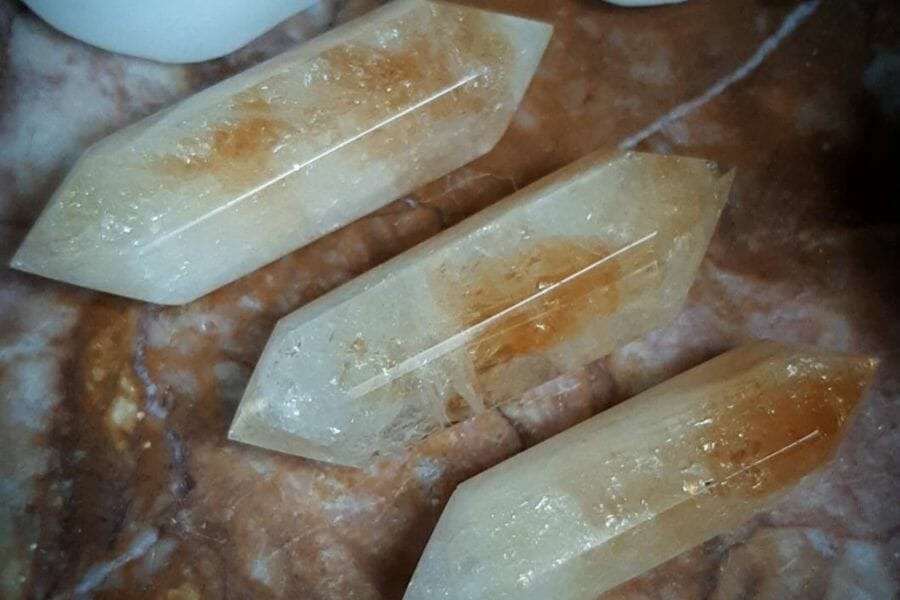
Photo provided by The Crystal Gem Unicorn
Many imitations and treatments exist in the market, making it difficult for consumers to identify real citrine. The most common you will run into are:
Common Imitations and Treatments
Imitations of citrine can come in many forms, from glass and resin to other yellow gemstones or synthetic materials. One of the most common treatments for fake citrine is heating amethyst, which turns the purple gemstone into a yellow-orange hue. However, heated citrine lacks the nuances and energies of natural citrine and may fade or darken over time.
Other imitations can be made by coating clear quartz or glass with a yellow film, giving the appearance of citrine without the inherent qualities.
Heat-Treated Amethyst
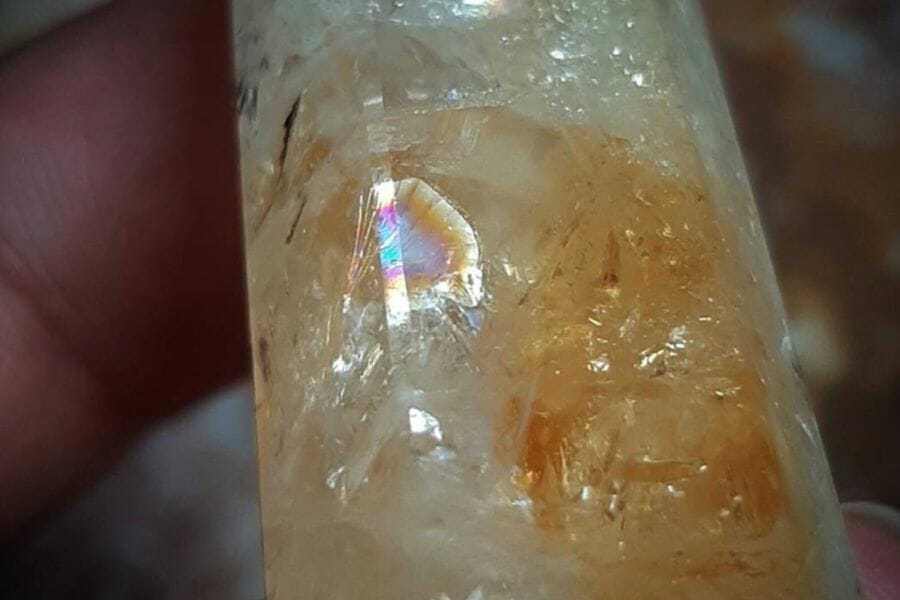
Heat treatment is a common practice in the gemstone industry, used to enhance or change the color of a gemstone. It is important to note that heat-treated gemstones can be of lesser value than their untreated counterparts and may have a shorter lifespan.
Heat-treated amethyst, like the image above, can resemble citrine, but it may have a cloudy appearance or lack the natural inclusions and characteristics of citrine, making it easier to spot a fake.
It is also worth noting that natural citrine can be heated to enhance its color, but this treatment is typically disclosed by reputable sellers and does not detract from the value or quality of the gemstone.
Glass and Resin Replicas
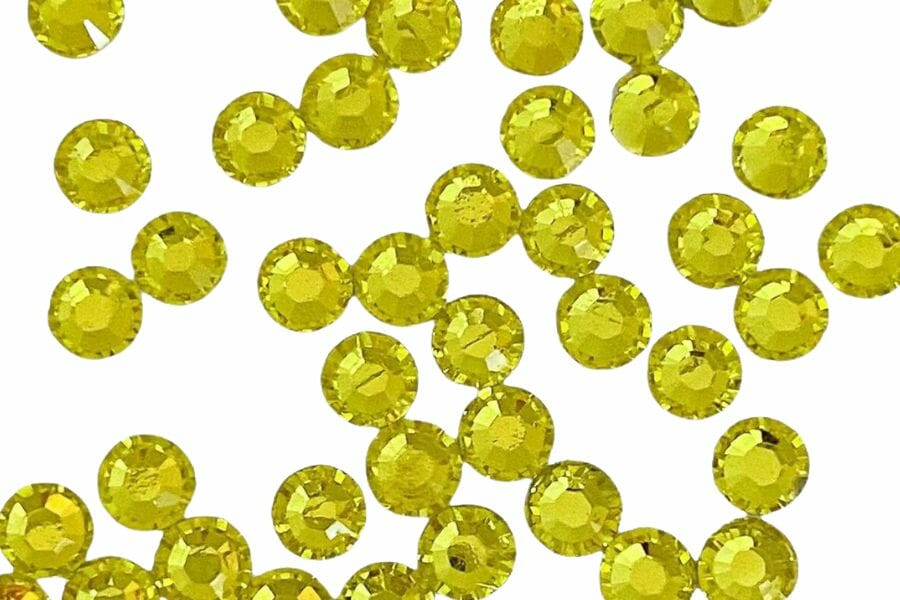
Glass or resin replicas of citrine can be difficult to spot, as they can have a convincing color and shine as you see in the image above. They lack the natural energy and qualities of citrine, making them less valuable and useful.
One way to differentiate between real and fake citrine is to touch the gemstone’s surface gently. Real citrine will feel cool and smooth, while glass or resin will have a slightly warmer surface.
Another way to identify a glass or resin replica is to examine the gemstone under a magnifying glass. Real citrine will have natural inclusions and imperfections, while replicas will have a more uniform appearance.
Testing Methods for Real Citrine
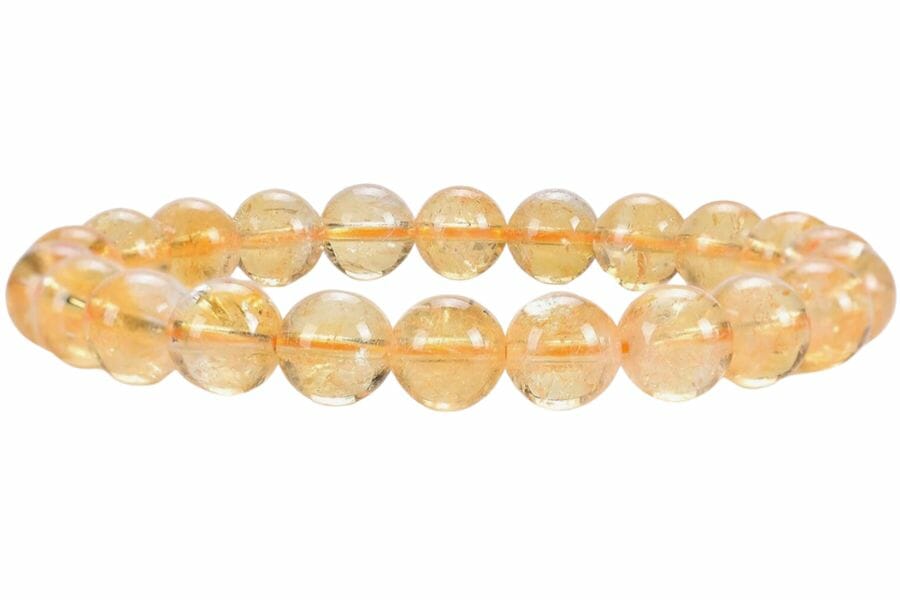
Photo provided by Glass Wing Organic
If you want to make sure that the citrine you have is authentic, there are several testing methods that you can use. These are a bit complicated and you may be better off skipping these in favor of other advice further down the article.
Visual Inspection
The first step in identifying real citrine is to look at it closely, either with the naked eye or a magnifying tool. Real citrine should have a consistent color, transparency, and inclusions, while fake citrine may have bubbles, cracks, or irregularities in its surface.
Real citrine will also have a natural crystal structure that sets it apart from replicas. When examining citrine, it is important to note that some genuine citrine may have inclusions or imperfections. However, these imperfections should be natural and not look like they were artificially created.
Specific Gravity Test
The specific gravity test measures the density of a gemstone relative to water. Natural citrine has a density of 2.65, while glass or resin replicas have a lower density, around 2.4. To conduct this test, you will need a scale that can measure in grams, a beaker, and water.
Weigh the citrine and record the weight. Then, fill the beaker with water and record the volume. Gently submerge the citrine in water and measure the displacement of water, subtracting the volume of the beaker. Divide the citrine’s weight by the water’s displaced volume to get its specific gravity.
This test is useful because it is difficult to replicate the natural density of citrine. If the specific gravity of your citrine is significantly lower than 2.65, it is likely that it is not real.
Refractive Index Test
The refractive index test measures how light interacts with a gemstone and can help identify its authenticity. Citrine has a refractive index of 1.544-1.553, which means it bends light at a specific angle. To conduct this test, you will need a refractometer, a gemstone holder, and a light source.
Place the citrine on the holder, position the refractometer over it, and shine the light through it. The refractometer will measure the angle at which light is refracted and provide a reading that can help identify genuine citrine.
This test is useful because it is difficult to replicate the refractive index of natural citrine. If the refractive index of your citrine is significantly different from 1.544-1.553, it is likely that it is not real.
How To Ensure You Buy Real Citrine
If you want to be 100% positive that you are buying real citrine or don’t want to perform the tests we mention above there are only a couple of ways to do that:
Buying from reputable sellers
One of the best ways to ensure that you are purchasing real citrine is to buy from reputable sellers. Reputable sellers will disclose any treatments or enhancements to the gemstone and provide certification of authenticity. They will also have a good reputation in the industry and be willing to answer any questions you may have about the gemstone.
Buying from reputable sellers not only ensures that you are getting a genuine citrine, but it also supports ethical and sustainable practices in the gemstone industry.
Have your citrine appraised before buying
If you are buying a citrine from someone directly you should consider having it appraised by an expert before buying. Look for sellers who specialize in citrine and who are members of professional organizations like The American Gem Society and the International Gem Society.
Highly Regard Citrine Dealers To Consider
Since dealing with reputable sellers is critical when buying or selling citrines we wanted to recommend a few options. There are a few highly regarded sellers that you should check out first:
For cut and polished citrine jewelry
- Artisan Crafted Silver – Online – USA
- Kendra Scott – Online – USA
For rough citrine
- GAF Treasures – Online – USA
- Spiritual Stone Store – Online – UK
- Vinas Healing Crystals – Online – USA
- World Incense Store – Online – USA

